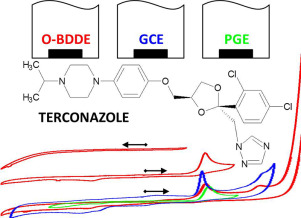当前位置:
X-MOL 学术
›
J. Electroanal. Chem.
›
论文详情
Our official English website, www.x-mol.net, welcomes your
feedback! (Note: you will need to create a separate account there.)
Voltammetric study of triazole antifungal agent terconazole on sp3 and sp2 carbon-based electrode materials
Journal of Electroanalytical Chemistry ( IF 4.1 ) Pub Date : 2020-04-01 , DOI: 10.1016/j.jelechem.2020.114054 Jan Fischer , Javier González-Martín , Paweł Lochyński , Hana Dejmková , Karolina Schwarzová-Pecková , Marisol Vega
Journal of Electroanalytical Chemistry ( IF 4.1 ) Pub Date : 2020-04-01 , DOI: 10.1016/j.jelechem.2020.114054 Jan Fischer , Javier González-Martín , Paweł Lochyński , Hana Dejmková , Karolina Schwarzová-Pecková , Marisol Vega

|
Abstract Terconazole belongs to synthetic triazole antifungal agents, inhibiting biosynthesis of ergosterol or other sterols and thus disrupting cell wall synthesis in fungi. In this study, electrochemical behavior of terconazole was studied for the first time using cyclic voltammetry and differential pulse voltammetry on boron doped diamond electrode (BDD) with different surface treatments leading to O-terminated, H-terminated and polished surfaces, as well as on glassy carbon (GCE) and basal-plane pyrolytic graphite electrodes (PGE). Terconazole is not reducible within the potential window on these electrode materials. It is oxidizable in aqueous solutions in pH range from 2.0 to 12.0 in two steps due to the presence of piperazine ring in its molecule, possessing two redox centers at the tertiary nitrogen atoms, by an ECE mechanism. Optimal conditions were found for determination of terconazole in 0.1 mol L−1 phosphate buffer pH 7.2. Using differential pulse voltammetry, the lowest detection limit of 0.40 μmol L−1 and excellent repeatability (RSD 1.1%) were achieved on O-terminated BDD when in-situ anodic activation was used prior to each scan. This is beneficial in comparison with GCE and PGE; their necessity of ex-situ polishing worsens the signal repeatability (RSD ~ 4%) and detection limits reaching 0.50 μmol L−1 and 1.23 μmol L−1, respectively.
中文翻译:

三唑类抗真菌剂特康唑对sp3和sp2碳基电极材料的伏安研究
摘要 特康唑属于合成三唑类抗真菌剂,可抑制麦角甾醇或其他甾醇的生物合成,从而破坏真菌细胞壁的合成。在这项研究中,首次使用循环伏安法和差分脉冲伏安法在硼掺杂金刚石电极 (BDD) 上研究了特康唑的电化学行为,该电极具有不同的表面处理导致 O 端、H 端和抛光表面,以及玻璃碳(GCE)和基面热解石墨电极(PGE)。特康唑在这些电极材料的电位窗口内是不可还原的。由于其分子中存在哌嗪环,在叔氮原子处具有两个氧化还原中心,通过 ECE 机制,它可以在 pH 值为 2.0 至 12.0 的水溶液中分两步氧化。找到了在 0.1 mol L-1 磷酸盐缓冲液 pH 7.2 中测定特康唑的最佳条件。使用微分脉冲伏安法,在每次扫描前使用原位阳极活化时,O 封端的 BDD 的最低检测限为 0.40 μmol L-1 和出色的重复性(RSD 1.1%)。与 GCE 和 PGE 相比,这是有益的;它们对非原位抛光的必要性使信号重复性(RSD ~ 4%)和检测限分别达到 0.50 μmol L-1 和 1.23 μmol L-1。与 GCE 和 PGE 相比,这是有益的;它们对非原位抛光的必要性使信号重复性(RSD ~ 4%)和检测限分别达到 0.50 μmol L-1 和 1.23 μmol L-1。与 GCE 和 PGE 相比,这是有益的;它们对非原位抛光的必要性使信号重复性(RSD ~ 4%)和检测限分别达到 0.50 μmol L-1 和 1.23 μmol L-1。
更新日期:2020-04-01
中文翻译:

三唑类抗真菌剂特康唑对sp3和sp2碳基电极材料的伏安研究
摘要 特康唑属于合成三唑类抗真菌剂,可抑制麦角甾醇或其他甾醇的生物合成,从而破坏真菌细胞壁的合成。在这项研究中,首次使用循环伏安法和差分脉冲伏安法在硼掺杂金刚石电极 (BDD) 上研究了特康唑的电化学行为,该电极具有不同的表面处理导致 O 端、H 端和抛光表面,以及玻璃碳(GCE)和基面热解石墨电极(PGE)。特康唑在这些电极材料的电位窗口内是不可还原的。由于其分子中存在哌嗪环,在叔氮原子处具有两个氧化还原中心,通过 ECE 机制,它可以在 pH 值为 2.0 至 12.0 的水溶液中分两步氧化。找到了在 0.1 mol L-1 磷酸盐缓冲液 pH 7.2 中测定特康唑的最佳条件。使用微分脉冲伏安法,在每次扫描前使用原位阳极活化时,O 封端的 BDD 的最低检测限为 0.40 μmol L-1 和出色的重复性(RSD 1.1%)。与 GCE 和 PGE 相比,这是有益的;它们对非原位抛光的必要性使信号重复性(RSD ~ 4%)和检测限分别达到 0.50 μmol L-1 和 1.23 μmol L-1。与 GCE 和 PGE 相比,这是有益的;它们对非原位抛光的必要性使信号重复性(RSD ~ 4%)和检测限分别达到 0.50 μmol L-1 和 1.23 μmol L-1。与 GCE 和 PGE 相比,这是有益的;它们对非原位抛光的必要性使信号重复性(RSD ~ 4%)和检测限分别达到 0.50 μmol L-1 和 1.23 μmol L-1。











































 京公网安备 11010802027423号
京公网安备 11010802027423号